Beijing No. 4 High School
| Beijing No. 4 High School (BHSF) 北京四中 | |
|---|---|
 | |
| Address | |
|
A2 West Huangchenggen North St., Xicheng District Beijing China | |
| Coordinates | 39°55′53″N 116°22′42″E / 39.931262°N 116.378257°ECoordinates: 39°55′53″N 116°22′42″E / 39.931262°N 116.378257°E |
| Information | |
| Type | Public |
| Motto | Diligence, Rigor, Democracy and Pioneering |
| Established | 1906 (as Shun-Tian Secondary School) |
| Principal | Liu Changming (刘长铭) |
| Faculty | 300 (Main Campus) |
| Number of students | 1500 (Main Campus) |
| Campus size |
14.53 acres (58788㎡)for Main Campus About 289 acres(1169000㎡) for all campuses |
| Campus type | Urban |
| Color(s) |
Dark Blue White |
| Branches |
Senior High Campus Junior High Campus International Campus Fangshan Campus Shunyi Campus Hohhot Campus |
| Anthem | Song of Hope and Ideal |
| Website |
www |
Beijing No. 4 High School (Chinese: 北京市第四中学; pinyin: Běijīng shì dìsì zhōngxué), commonly abbreviated as (Beijing) Sizhong (Chinese: 北京四中), and sometimes referred to as Beijing High School Four (BHSF), is a public beacon high school in Xicheng District, Beijing, China. It is one of the most prestigious high schools in China.[1] It was established in 1907 by the Shuntian Government (Beijing Government) during the Qing dynasty, known as the Shuntian Secondary School. After the Xinhai Revolution, the school was renamed as Capital Public No. 4 Secondary School (京师公立第四中学), which was not changed into the current name until 1949, when the People's Republic of China was proclaimed. The school was among the first to be accredited as a "Municipal Model High School" by the Beijing Municipal Commission of Education. More than 300 students from the school have won medals in municipal, national and international competitions every year. More than 96 percent of its graduates passed the enrolment line of key universities (Tier 1 schools) in National Higher Education Entrance Examination.[2] In a 2016 ranking of Chinese high schools that send students to study in American universities, Beijing No. 4 High School ranked number one in mainland China in terms of the number of students entering top American universities, and number four internationally for high schools outside of the United States.[3][4] Many Chinese politicians and their children have attended Beijing No. 4.
History
Qing Dynasty period
Beijing No. 4 High School is one of the oldest schools in Beijing. Its predecessor Shuntian Secondary School (顺天中学堂) was founded in 1906 by the then Shuntian Government (Peking Government) of the Qing dynasty. Along with a few other primary and secondary schools established, the Qing government nullified the imperial examination system and commenced a more institutional system on academic studies and education as a result of the Hundred Days' Reform.
Republic of China period
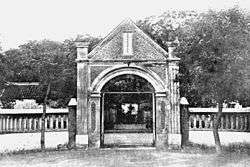

During the Republic of China (ROC) period, the Capital Department of Education Affairs (京师学务局) exercised jurisdiction over the school and renamed it Capital Public No. 4 Secondary School (京师公立第四中学) on September 29, 1912, which is thus the anniversary commemorated until today.
The May Fourth Movement of 1919 involved representative students from the school to parade and assemble at Tiananmen. After the city was invaded in 1939 by Japan, the school was mandated to conduct education of enslavement by Japan. The surrender of Japan in 1945 ended enslaved education, and the ROC government took over, with Sun Lubin (孙鹿宾) being principal. At that time, the secret service of the Communist Party(CPC) had been developing secret CPC members within the school.
In 1945, alumni from Tsinghua University, Yenching University and Peiyang University who argued against the Chinese Civil War propagated their ideas to Senior Grade 3 students in an auditorium in the Beijing No.4 High School. When the local police arrived and besieged the auditorium, a conflict with the students broke out, with several students injured by bayonet. The police then bound the alumni. The Mayor of Peking, He Siyuan, dispatched personnel to unbind them and apologized to the students.
From late 1948 to early 1949, the school was forced to cease its teaching and suspend classes when the Kuomintang army occupied the school, turned its buildings and campus into barracks and battlefield to fight against Communist Party in the Civil War.
Post 1949 period
The Communist Party assumed control of the city on January 31, 1949. On March 15, the Beijing Military Management Commission (北京市军管会) sent Li Fusheng (李复生) to take over the school as principal. In April 1949, it set a Youth League branch and a Communist Party branch, and established a students union. It was at this time that the school was renamed to Beijing No.4 High School (北京市第四中学).

On November 7, 1995, the then CPC general secretary, Chinese President Jiang Zemin paid a visit to the school. He highly praised it, observing:
I’ve long heard of your great name, reverberating like thunder. I’m greatly honored to be here.[5]
The Department of International Students was established in 2002. Since then, international students from at least 25 countries including Korea, Japan, New Zealand, Australia and Canada started to enroll in Beijing No.4 High School.
The International Olympic Committee (IOC) sent an evaluating delegation to inspect Beijing in February 2001. The No.4 High School was the only educational organ that received the evaluating committee. It was believed to have contributed to the success of Beijing in the 2008 Summer Olympics bidding.
On August 6, 2007, IOC President Jacques Rogge visited the school and delivered a speech there.[6][7]
Incumbent Chinese Premier Wen Jiabao visited the No.4 High School on September 4, 2007. There, he remarked:
Beijing No.4 High School is supposed to be developed into a world-class one and China should have more schools of this kind. This is our hope.[8]
On August 7, 2008, the day before the opening ceremony of the Olympic Games, the school was visited by the wife of IOC President Jacques Rogge, Anne Rogge and other foreign guests.[9]
On May 5, 2011, NBA player Roy Hibbert of Indiana Pacers visited the school as a part of the NBA Cares program. Roy Hibbert taught students some basketball tactics and skills.[10]
Main Campus
The Main Campus of BHSF is located within the area of Imperial City of old Beijing. It serves as the home of the BHSF's senior high school programs.
Old campus

Historically, Shun Tian Secondary School (顺天中学堂) was situated in Wanping Senior Primary School (宛平高等小学堂) Capital Houku (京师后库) (Houku, Xicheng District, Beijing). The very old campus had been renovated and rebuilt many times, while the site was not changed. It occupied 65,733 m², of which the playground occupied 27,067 m², including basketball courts, tennis courts, football pitch, and volleyball courts. On the campus, there were around 1,500 trees and flowers in approximately 100 kinds. It also had a botanical garden where crops grown and a well pavilion.
Current campus

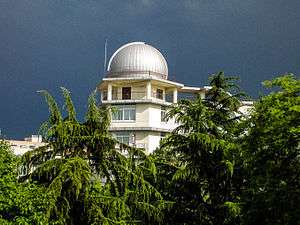
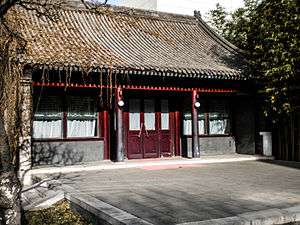
Main Building
Each floor of this four-storey structure has eight classrooms shaped in hexagons instead of traditional rectangles. This design facilitates large capacity, small sight range and small visual angle that are really conducive to teaching and learning in the classrooms. The corridors shaped by the hexagonal classrooms are also convenient for emergency evacuation and break-time amusement.
Other buildings
The People's Municipal Government of Beijing rebuilt the school in 1983 and it was shrunk to an area of 46372 m². The school was designed by architect Huang Hui.[11]
The principal's office is the only structure in archaic style, which is conserved from the old campus period. The office has a balcony popularly known as Wang Yue Tai (望月台, literally the Terrance of Moon View). The 6-floor Technology Building has laboratories for chemistry, physics, biology, and computer sciences. On the sixth floor, there is an observatory for astronomy clubs.The Administration Building, built in 2003, has offices for teachers and staff and conference or meeting rooms.
The school offers a stadium with plastic field surrounded by 400-meter running tracks. In the stadium, there are two volleyball courts, one large soccer pitch, six basketball playgrounds, several gymnastic facilities, and other track and field facilities. A multi-purpose gymnasium is also inside of the school, where there are rooms for table tennis, a gym and a 200-meter swimming pool. Rooms for martial arts, ballet dance and other sports are also found on campus.
There are also cafeterias, auditoria, a library, a health center, an art building, students' dormitories, and many other buildings on campus.
The corridor from Main Building to Technology Building is one of the more notable characteristics in Beijing No.4 High School.
Branch Campuses
Junior High Campus
Junior High Campus (or Beihai Park Campus) is located several blocks away from the Main Campus. It is within the Green Belt of Beihai Park, a famous historical site with lake views. It used to be the home of Beihai Middle School, which merged with Beijing No.4 High School in 2005. Now, this campus is served as the home of BHSF's junior high school programs.
International Campus
International Campus (or Business Street Campus) of Beijing No.4 High School (commonly abbreviated as BHSFIC) has been the home of BHSF's oversea classes since 2012. It is a small campus located on the Business Street of Xicheng District, Beijing. Students of this campus are registered as a part of the student body of Main Campus. There are a 2-year Global Scholar Program and a 3-year Global Scholar Program available at this campus.
Shunyi Campus
Shunyi Campus is a branch school of Beijing No.4 High School located in Shunyi, a district of Beijing. It has a huge campus (230 acres) and runs both junior and senior high school programs. Usually, however, this school is only considered as an affiliated school to BHSF administrated by the same school officials. Students there are not usually considered as a part of the student body of Main Campus, for their admission requirements and scores are different from those in Main Campus.
Fangshan Campus
Opened in 2014, the Fangshan Campus is the newest campus of Beijing No.4 High School. It is located in Fangshan, a satellite town outside of central Beijing. Buildings and facilities in this campus are totally environmental friendly. Similar to the Shunyi Campus, Fangshan Campus is usually considered as an affiliated school to BHSF.
Hohhot Campus
The Hohhot Campus of Beijing No.4 High School is the only BHSF branch campus that is not in Beijing Municipality. Instead, it is in the city of Hohhot, the capital of Inner Mongolia. It is a high school ran by the local government of Hohhot but working on a very deep integration with Beijing No.4 High School. This campus opened in 2012, and it became one of the best and most reputable high schools in Inner Mongolia only after two years.
Beijing No.4 Online School
Beijing No.4 Online School is a distance education platform of Beijing No.4 High School. It is a perfect combination of high technology and good education resources, which connects teachers and students in No.4 High School and the others elsewhere. Beijing No.4 Online School offers countrywide online courses to students in elementary schools and high schools. It is an open platform with rich resources.[12]
Administration
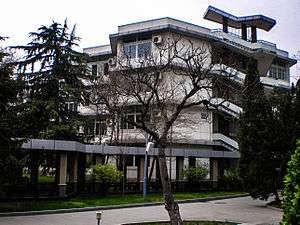



- Academic Departments
- Literature
- Mathematics
- English
- Physics
- Chemistry
- History
- Geography
- Politics (Politics, Economics and Philosophy)
- Arts (Music and Fine Arts)
- Biology
- Engineering
- Academic Affairs
- Teaching and Researching
- Student Departments
- Grades and Classroom Groups
- Student Regular Management
- Morality Office
- Student Government
- Student TV Channel
- Residential Halls
- Health Departments
- Physical Education
- Health Center
- High School Varsity Teams
- Sport Facilities
- Media Departments
- Media Technology
- Computer Sciences
- Internet Development
- General Service Offices
- Finance and Bureau
- Library
- General Management
- Supporting
- Dining Hall
- Telephone and Communication
- Administration Offices
- Registration
- Document
- School History Exhibition
- Security
- Drivers
- Alumni Association
- Oversea Class and Office
- School Property Management
- Civil Construction
- Affiliated Parts
- Swimming Instruction
- Souvenirs Store
- Digital Resource
- Extracurricular Institute
- International Center
- Online Program
Academic and student lives

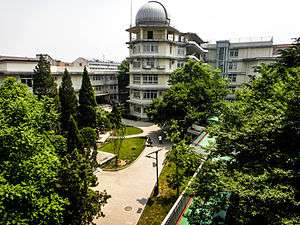

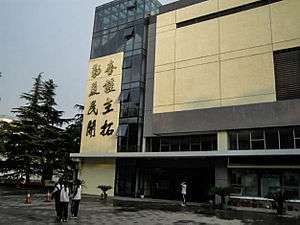
Academic
Beijing No.4 High School is one of the top Chinese high schools with stellar reputation on academics. It is one of the first schools in China that offers different mathematics and English classes to different students according to their academic performances. Each year, around 300 students win awards in national-level competitions in subjects including mathematics, physics, chemistry, biology and computer sciences. In International Science Olympiad, students from this school have won 7 gold medals, 3 silver medals and 1 bronze medal. The school also has talent program called Daoyuan class.
Beijing No.4 High School is known for its high average score in National Higher Education Entrance Examinations. Its average score is higher than most other high schools in Beijing. Every year, about forty percent of students from this high school could be admitted by Peking University and Tsinghua University, the two best universities in China. A larger portion of students will attend other highly ranked institutes, such as Nanjing University, Zhejiang University, Fudan University, Shanghai Jiaotong University, Renmin University, University of Science and Technology of China, Wuhan University and Sichuan University, which are often regarded as Ivies of China. Some students will be accepted by top institutes in Hong Kong, like Hong Kong University, Chinese University of Hong Kong and Hong Kong University of Science and Technology.
Every year, about 60 students from this high school will choose to study abroad after graduation. Top American private schools including Harvard, Yale, MIT, Cornell, Stanford, Penn, Chicago and Duke frequently admit students from Beijing No.4 High School. Some other students are enrolled in liberal arts colleges such as Amherst and Wellesley. The rest half of those students, however, will receive offers from top public giants like California, UCLA, Michigan, North Carolina, Wisconsin, Texas and Virginia.
Required and elective courses
All students are required to take all core courses of 14 subjects, including Chinese Literature, Mathematics, Chemistry, Physics, Biology, English, History, Political Sciences, Geography, Musicology, Fine Arts, Basic Engineering Skills, Computer Science and Physical Education. In the second year of senior high school, students will be divided into two groups based on their interests and career plans. Liberal-Arts oriented students need to complete more courses in History, Politics (including Philosophy, Economics and Political Sciences) and Human Geography, while Sciences-and-Engineering oriented students need to take more credits in Mathematics, Biology, Chemistry and Physics. Besides, one research project is required for each academic year, and internships or volunteer activities should be completed. Specifically, all students have to pass the swimming-skill test before graduation. Training and exercises in military, agriculture and business are usually required.
In addition to those required courses, students need to take one elective course every semester. Topics of those elective courses vary widely, including but not limited to film study, classical music, history of World War II, poetry, fashion design, photographing, industrial engineering, programming, 3D cartoon design, interior design, cooking, ancient Chinese, quantum physics, psychology, historical geography, GIS, guitar, harmonica, French, mass media, economics, modelling and dissection.
Physical Education
Beijing No.4 High School regards Physical Education as one of the most important part of high school curriculum. From the first day of class till the day before graduation, it requires all students to take at least one hour PE class every day. The winter-day long-distance race is a tradition of this school. The PE classes are also divided into required ones and elective ones. The required classes are gymnastic, track and field, martial arts, basketball, swimming and theory lectures; elective courses include upper levels of previous ones and soccer, volleyball, table tennis, baseball, fitness and Bridge Card. Noticeably, as mentioned above, all students must pass swimming test before graduation. During the three-year period, most students are also required to take part in a 2-week military training and several field trips and field training to build up their perseverance, confidence, leadership and teamwork skills.
Beijing No.4 High School has several varsity teams, and its soccer team, basketball team and martial arts team are powerhouses in high school tournaments.
Organizations
There are dozens of student organizations in Beijing No.4 High School, with themes varying from natural sciences to liberal arts. Some most popular organizations are Societies, Associations or Clubs of Archaeology, Hip-Pop, Ballet, Debate, Sciences and Technology, Literature, Drama, Choir, Philanthropy, Astronomy, Chinese Civilization and Model United Nations.
Culture
Facts
- The calligraphic title Beijing Sizhong (北京四中, literally Beijing No.4 High School ) was inscribed by Guo Moruo.
- The school emblem features the Old Gate built in 1929.
- The school anthem Song of Hope and Ideal is composed by composer Shi Guangnan.
- On every May Fourth Day's night, there are Evening Parties of Lights on campus.
- The old version of school uniform has a nickname Penguin, for it has white background with dark-blue sleeves which make it looks like a penguin. However, the old version of school uniform was replaced by Japanese and Korean styled new version in 2010.
Wang Daoyuan's admonishment
Wang Daoyuan was the first principal of Beijing No.4 High School. His admonishment to first students is curved on a glacial gravel and placed on campus:
You need to know that you are born to stand on your own feet, and to advocate and follow moral behaviors. If you act charitably to others, you can harvest respect and support. However, if you greedily affiliate with power and authority, eventually you will be in trouble, so never do that. It is your knowledge base rather than others' power that will help you the most. You are not able to obtain knowledge without real-life practice. Nowadays, many scholars and students are always afraid that no one will discover their talent and promote them, but few really think of contributing their skills to their communities. I think they are on a wrong way. Learning will be endless, so will the community service be, and that is why one should never stop exploring new things. People without moral excellence cannot get this idea, neither can those vulgar playboys. Now you are in your best ages, and you are dreaming big. Will you choose to be people who will make great contribution to the community and society? Or just to be some of those vulgar ones? You have to think twice. Go and find it!
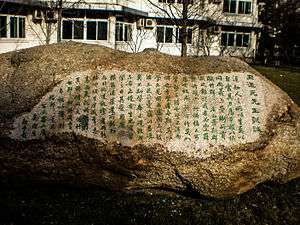
Sister schools
-
 United Kingdom London Westminster School[13]
United Kingdom London Westminster School[13] -
 United States Chicago Walter Payton College Prep[13]
United States Chicago Walter Payton College Prep[13] -
 United States Texas St. John's School[13]
United States Texas St. John's School[13] -
 United States California Sonoma Academy[13]
United States California Sonoma Academy[13] -
 United States Utah Park City High School[13]
United States Utah Park City High School[13] -
 Singapore Singapore NUS High School[13]
Singapore Singapore NUS High School[13] -
 New Zealand Christchurch Christchurch Boys' High School[13]
New Zealand Christchurch Christchurch Boys' High School[13] -
 South Korea Seoul Seoul Science High School[13]
South Korea Seoul Seoul Science High School[13] -
 Republic of China Taipei Taipei First Girls' High School[13]
Republic of China Taipei Taipei First Girls' High School[13] -
 Republic of China Taipei Taipei Municipal Jianguo High School[13]
Republic of China Taipei Taipei Municipal Jianguo High School[13] -
 Republic of China Taichung Ming-Dao High School[13]
Republic of China Taichung Ming-Dao High School[13] -
 Republic of China Taipei Taipei Municipal Zhongshan Girls High School[13]
Republic of China Taipei Taipei Municipal Zhongshan Girls High School[13] -
 Republic of China Taipei Taipei Wego Private Senior High School[13]
Republic of China Taipei Taipei Wego Private Senior High School[13] -
 United Kingdom Berkshire Eton College[13]
United Kingdom Berkshire Eton College[13]
Notable alumni
- Yu Xiaoyi, financial analyst, and future venture capitalist[14]
- Chen Jingrun, a Chinese mathematician and Chinese Academy of Sciences academician[15]
- Feng Yuanzheng, a scientist and professor in California Institute of Technology, regarded as the founding figure of bioengineering, tissue engineering, and the "Founder of Modern Biomechanics";
- Fang Lizhi, an astrophysicist; a professor at University of Arizona[16]
- Ling Qing, former Permanent Representative of China to the United Nations (1980-1985)
- Li Ao, a Taiwanese writer, social commentator, historian, and independent politician[17]
- Wang Meng, a writer; previously the vise president of Ministry of Culture of the People's Republic of China[18]
- Xie Fei, a film director;famous films include Black Snow and Woman Sesame Oil Maker.
- Bei Dao, a poet and three times Nobel Prize in Literature nominee[19]
- Chen Kaige, a film director; notable films include Farewell My Concubine, Together, The Promise and Caught in the Web.[18]
- Gao Xiaosong, a singer and musician[18]
- Wang Kunlun, a Chinese politician and co-founder of the Revolutionary Committee of the Kuomintang
- Yu Zhengsheng, one of top Chinese politicians
- Ding Weiyue, a Chinese Academy of Sciences academician in math. Professor at Peking University.
- Tu Chuanyi, a Chinese Academy of Sciences academician in earth and spatial sciences. Professor at Peking University.
- Mao Erke, a scientist in radar and information technology. Professor at Beijing Institute of Technology.
- Bo Xilai, a former Chinese politician; On 22 September 2013, Bo was found guilty of corruption, stripped of all his assets, and sentenced to life imprisonment.
- Ma Kai, a Chinese politician[18]
- Yu Fuchun, the former chair and professor at Department of Physics at Peking University.
- Ngapoi Jigme, former president at Radio Free Asia
- Wang Zhuang, vise chief designer of Shenzhou Spaceship.
- Liu Yuan, a Chinese politician and serviceman; previously the vise commander of Chengdu Military Region[18]
- Yu Dan, a scholar in Ancient Chinese Civilization and Literature.
- Zhong Binglin, vise president of Beijing Normal University.
- Wang Chongyu, a Chinese Academy of Sciences academician in physics. A professor at Tsinghua University.
- Zhou Xiaozheng, a famous socialist and professor at Renmin University
- Cong Weixi, a famous writer
- Zhang Zhaoxi, a Chinese Academy of Sciences academician in physics.
- Shi Yaolin, a Chinese Academy of Sciences academician in earth sciences.
- Hao Bolin, a Chinese Academy of Sciences academician in physics.
- Liu Yushan, a politician; the Secretary-General of the Executive Yuan in 2005-2007.
- Shu Chang, an actress who played roles in Xiaozhuang Mishi, The Story of a Noble Family, Huang Taizi Mishi, Lian Cheng Jue, Demi-Gods and Semi-Devils and Royal Tramp.
- Ding Guoyu, a famous scholar in geology and geophysics. Chinese Academy of Sciences academician.
- Xi Xiaohu, a manager at Google.
- Zhang Lu, a famous soccer game commentator. Vise chair of board of Beijing Guoan F.C..
- Wang Wencai, a Chinese Academy of Sciences academician in biology.
- Li Yiyun, a writer and a professor at University of California, Davis.
- Lin Liguo, the person in charge of Project 571 Outline.
- Kong Dan, an entrepreneur and economist; president of China Everbright Group.
- Shen Zhihua, a historian researching on cold war; a professor at East China Normal University and a guest lecturer at Chinese University of Hong Kong.
- Zhang Shunjiang, the very first Chinese professor in sciences of decision making. Professor at University of Science and Technology of China. Visiting professor at New York University.
- Li Qiang, professor and chair of School of Social Sciences at Tsinghua University. Visiting scholar at Bristol University and University of Michigan.
See also
- High School Affiliated to Renmin University of China (Beijing No.4 High School's biggest rival in culture, athlete and academics)
- Beacon high schools in Beijing
References
- ↑ Wong, Edward. "In China, Breathing Becomes a Childhood Risk" (Archive). The New York Times. April 23, 2013. Retrieved on October 19, 2015.
- ↑ "Beijing No.4 High School". Archived from the original on May 3, 2014. Retrieved July 15, 2011.
- ↑ Sohu Education "http://learning.sohu.com/20160128/n436133150.shtml" Jan 28, 2016.
- ↑ CollegeNode Ranking ""Archived copy". Archived from the original on October 14, 2016. Retrieved April 5, 2016."
- ↑ "全国百所重点中学网站:北京四中". Archived from the original on July 22, 2011. Retrieved July 15, 2011.
- ↑ "Rogge visits Olympic Education Model School". Retrieved July 15, 2011.
- ↑ "国际奥委会主席罗格考察北京四中". Retrieved July 15, 2011.
- ↑ "温家宝考察北京四中纪实:学校代表着国家的未来". Retrieved July 15, 2011.
- ↑ "罗格夫人参观北京四中[组图]". Retrieved July 15, 2011.
- ↑ "罗伊-希伯特现身北京四中 亲自传授禁区内进攻技巧". Archived from the original on August 11, 2011. Retrieved July 16, 2011.
- ↑ "Women in Architecture". China. ARVHA. Archived from the original on March 26, 2012. Retrieved February 5, 2012.
- ↑ http://baike.baidu.com/view/5022.htm?fromtitle=%E5%8C%97%E4%BA%AC%E7%AC%AC%E5%9B%9B%E4%B8%AD%E5%AD%A6&fromid=6756862&type=syn#10
- 1 2 3 4 5 6 7 8 9 10 11 12 13 14 "友好学校". Retrieved July 16, 2011.
- ↑ http://www.virginia.edu
- ↑ Pan, Chengtong; Wang, Yuan (1996). "Chen Jingrun: A Brief Outline of His Life and Works". Acta Mathematica Sinica. 12 (3): 225–233. Retrieved December 22, 2012.
- ↑ Fisher, Arthur (August 1996). "Man Without a Country". Popular Science. New York, NY: Times Mirror Magazines/Bonnier Corp. 249 (2): 62. ISSN 0161-7370. Retrieved July 16, 2011.
By the time Fang entered High School No. 4, the best in Beijing, he had become even more interested in what lay behind how things work.
- ↑ "这就是李敖". Retrieved July 16, 2011.
- 1 2 3 4 5 "北京四中 皇城根里"第一牛中学"". 《看天下》. Retrieved July 16, 2011.
- ↑ "北岛:北京四中". Retrieved July 16, 2011.
External links
| Wikimedia Commons has media related to Beijing No.4 High School. |